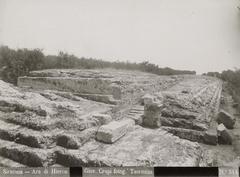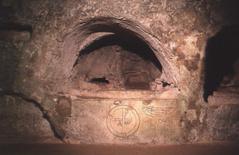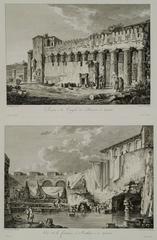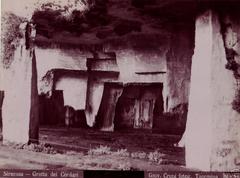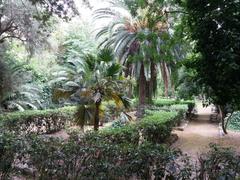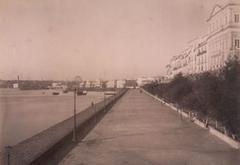
Grotta del Ninfeo: Visiting Hours, Tickets, and Historical Significance in Syracuse, Italy
Date: 04/07/2025
Introduction
Nestled within the Parco Archeologico della Neapolis in Syracuse, Sicily, the Grotta del Ninfeo stands as a remarkable testament to ancient engineering, religious devotion, and artistic inspiration. Carved into Temenite Hill in the 5th century BCE, this artificial grotto—originally a nymphaeum—served as a sacred sanctuary dedicated to nature deities and the Muses. Its perennial spring, sophisticated waterworks, and proximity to the Greek Theatre highlight its pivotal role in the spiritual and cultural life of classical Syracuse (UNESCO; Regione Siciliana).
Today, the Grotta del Ninfeo is a celebrated attraction within a UNESCO World Heritage archaeological park. This comprehensive guide details the grotto’s history, architectural features, cultural significance, and provides essential visitor information such as opening hours, ticketing, accessibility, and travel advice. Whether you are a history buff or a casual traveler, this resource will help you make the most of your visit to one of Syracuse’s most fascinating ancient sites.
Table of Contents
- Introduction
- Historical Background
- Visiting the Grotta del Ninfeo
- Conservation and Cultural Legacy
- Frequently Asked Questions (FAQ)
- Conclusion and Travel Tips
- References
Historical Background
Origins and Early Use
The Grotta del Ninfeo was hewn from limestone in the 5th century BCE, during Syracuse’s classical golden age. Functioning as a nymphaeum, it was dedicated to nymphs—nature spirits associated with springs and fertility. The grotto’s continuous spring made it an important site for ritual purification and religious ceremonies, especially during festivals devoted to Dionysus (UNESCO).
Architecture and Engineering
Measuring approximately 18 meters deep and 6 meters wide, the Grotta del Ninfeo features a vaulted ceiling, a rectangular basin fed by a perennial spring, and carved wall niches. These niches likely held votive offerings or statues. The sophisticated hydraulic systems not only provided water for ritual use but also supplied the adjacent Greek Theatre, reflecting the engineering prowess of ancient Syracuse (Regione Siciliana).
Religious and Artistic Significance
Beyond its role as a nymphaeum, the grotto is believed to have served as a Mouseion—a sanctuary for the Muses, goddesses of the arts. It was a preparatory space for actors and playwrights before performances in the nearby Greek Theatre. Archaeological evidence, including sculptural niches and water motifs, underscores its dual function as a religious and artistic hub (Oxford Classical Dictionary; Wikipedia).
Later Transformations
After Syracuse fell under Roman rule in 212 BCE, the site’s religious function diminished, and its use shifted towards leisure and practical water supply. In the medieval period, monastic activity is indicated by Christian symbols found in and around the grotto. During the Spanish era, the spring’s water powered mills, with remnants still visible today (Sicily Heritage).
Rediscovery and Modern Research
The Grotta del Ninfeo attracted renewed scholarly interest in the 18th and 19th centuries. Systematic archaeological excavations began in the early 20th century, led by Paolo Orsi. Recent research using advanced mapping and ground-penetrating radar has revealed further details of the site’s ancient hydraulic systems (Archaeological Institute of America).
Visiting the Grotta del Ninfeo
Visiting Hours
The Grotta del Ninfeo is open daily as part of the Parco Archeologico della Neapolis. Standard hours are typically from 8:30 AM to 7:00 PM (last admission at 6:00 PM or 6:30 PM, depending on the season). Hours may vary on holidays or for special events, so visitors should confirm details on the official park website.
Tickets and Entrance Fees
Entry to the Grotta del Ninfeo is included in the general admission ticket to the Parco Archeologico della Neapolis. Adult tickets cost around €10–€15, with reduced rates for EU citizens aged 18–25, students, and seniors. Children under 18 often enter free. Tickets can be purchased online or at the park entrance.
Accessibility and Travel Tips
- Location: The park is centrally located in Syracuse, with easy access via public transport, taxi, or a short walk from the city center.
- Terrain: The route to the grotto involves an uphill walk with some uneven paths and steps; suitable footwear is recommended.
- Accessibility: While parts of the park are accessible, the grotto itself is not wheelchair accessible due to its terrain. Assistance is advisable for those with limited mobility.
- Best Times to Visit: Early morning and late afternoon provide the best lighting for photography and a quieter experience.
- Amenities: Restrooms, a café, and a bookshop are available near the park entrance. Drinking fountains are present; bringing a reusable bottle is encouraged.
Guided Tours and Events
Guided tours in multiple languages are available and highly recommended for deeper insight. Special events, such as small theatrical performances and educational workshops, are sometimes hosted in the grotto or nearby during the annual Greek Theatre Festival (INDA Foundation).
Photography
Personal photography is permitted without flash to protect ancient surfaces. Commercial shoots require prior permission; drones are not allowed in the park.
Conservation and Cultural Legacy
Ongoing preservation efforts safeguard the Grotta del Ninfeo’s architecture and hydraulic systems, ensuring its longevity as both a historical monument and a source of inspiration. The site remains integral to community education, cultural events, and research on ancient engineering and religious practices (Sicilia Archeologica).
Frequently Asked Questions (FAQ)
Q: What are the Grotta del Ninfeo visiting hours?
A: Usually 8:30 AM to 7:00 PM, with seasonal changes. Confirm on the official website.
Q: How much does entry cost?
A: Adult tickets are €10–€15, with discounts for students, seniors, and children.
Q: Is the Grotta del Ninfeo accessible for wheelchair users?
A: The grotto is not wheelchair accessible due to uneven terrain, but the park offers accessible routes to other attractions.
Q: Are guided tours available?
A: Yes, in several languages; booking in advance is recommended.
Q: When is the best time to visit?
A: Early morning or late afternoon for optimal light and fewer visitors.
Q: Can I take photos?
A: Yes, personal photography is allowed without flash.
Conclusion and Travel Tips
The Grotta del Ninfeo offers a unique journey into the ancient world, blending spiritual, artistic, and engineering marvels in an evocative natural setting. Thoughtful conservation, modern visitor amenities, and interpretive resources enhance the experience for all. To fully appreciate your visit, consider joining a guided tour, arriving early or late in the day, and exploring nearby historical sites such as the Greek Theatre and the Museo Archeologico Regionale Paolo Orsi.
For the latest information on visiting hours and tickets, consult the Parco Archeologico della Neapolis official website. To enrich your experience, download the Audiala app for audio guides and live event updates.
References
- Grotta del Ninfeo - UNESCO World Heritage, 2023 (UNESCO)
- Parco Archeologico della Neapolis Official Site, 2024 (Parco Archeologico della Neapolis)
- Regione Siciliana - Parco Archeologico della Neapolis, 2024 (Regione Siciliana)
- Oxford Classical Dictionary Entry on Nymphaea and Greek Sanctuaries, 2022 (Oxford Classical Dictionary)
- Wikipedia - Grotta del Ninfeo, 2023 (Wikipedia)
- Siracusa Travel - Grotta del Ninfeo Visitor Information, 2023 (Siracusa Travel)
- Sicilia Turismo - Visit Sicily Information, 2024 (Sicilia Turismo)
- Sicilia Archeologica - Grotta del Ninfeo Research and Conservation, 2023 (Sicilia Archeologica)
- Archaeological Institute of America - Syracuse Fieldwork, 2023 (Archaeological Institute of America)
- Museums and Nymphaea in Magna Graecia, JSTOR, 1980 (JSTOR)
- INDA Foundation - Syracuse Theatre Festival, 2024 (INDA Foundation)


